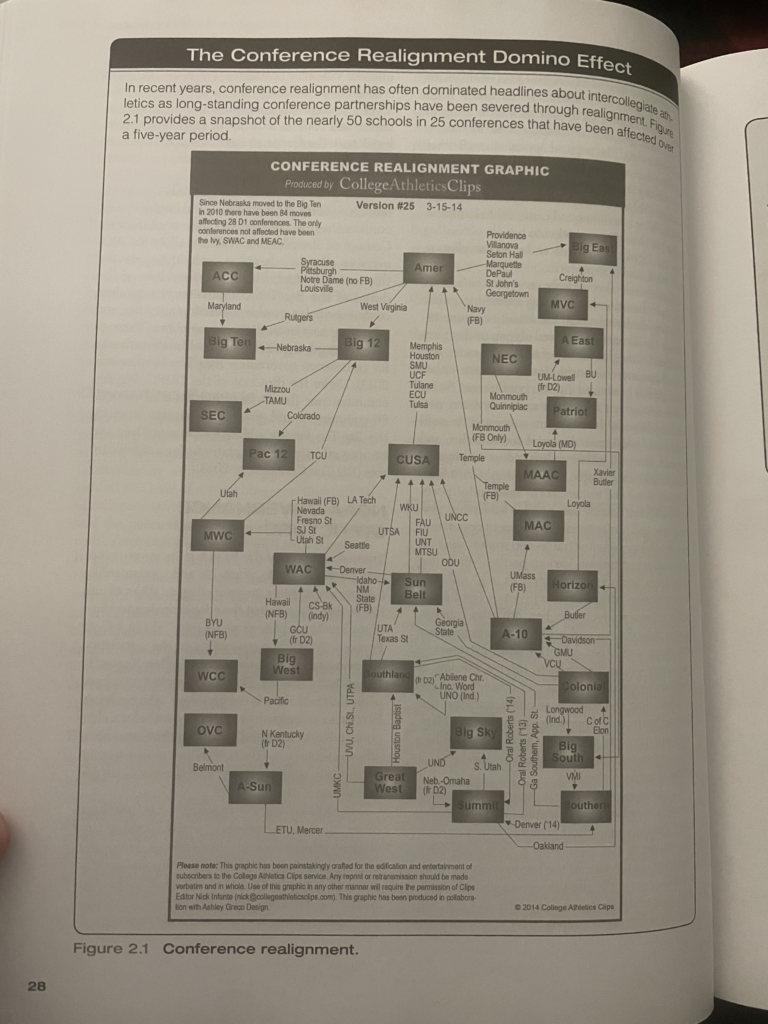The NCAA regulations have grown over time and now include:
- Institutional control
- Student-athletes’ well-being
- Gender equity
- Good sporting behavior and ethical conduct
- Sound academic standards
- Nondiscrimination
- Diversity in governance structure
- Rules compliance
- Amateurism
- Competitive equality
- Recruiting governance
- Eligibility governance
- Financial aid governance
- Governance of playing and practice seasons
- Governance of postseason competition
- Governance of economic program operation
The NCAA has a different manual for each of its three divisions. Division I has the most complex governance, as one would expect. However, Title IX applies equally to all three divisions.
The NCAA text describes institutional responsibility as follows:
Each institution shall comply with all applicable rules and regulations of the Association in the conduct of its intercollegiate athletics programs. It shall monitor its programs to assure compliance and to identify and report to the Association instances in which compliance has not been achieved. In any such instance, the institution shall cooperate fully with the Association and shall take appropriate corrective actions. Members of an institution’s staff, student-athletes, and other individuals and groups representing the institution’s athletics interests shall comply with the applicable Associate rules, and the member institution shall be responsible for such compliance.
NCAA, 2013a, p4
The Compliance Office is an org within a university staffed with one or more Compliance Officers (the book doesn’t specifically say they’re a team but it’s unfathomable that Alabama Football doesn’t have a team).
Recruiting definitions:
- Contact
- Face-to-face meeting with student and/or parents
- Contact Period
- Time when in-person contact at campus, watching games, and phone/written conversations are permitted
- Dead Period
- No direct contact, written/phone still allowed
- Evaluation
- Watching student compete
- Evaluation Period
- Time when coach may evaluate, write/phone but not have contact
- Official Visit
- Any visit paid for by the college
- College can pay for transportation, meals, and reasonable entertainment expenses
- Prospective Student-Athlete
- Starting in 9th grade, or
- Earlier than 9th grade if you receive financial aid or benefit from the college
- Quiet Period
- No contact or evaluation, but may visit and have written/phone correspondence
- Unofficial Visit
- Not paid for by the college
- Verbal Commitment
- Not binding, unlike signed letter
Violations of NCAA regs:
- Secondary Violations
- Unintentional and minor infractions
- Typically an isolated or inadvertent breach
- Typically provides no competitive advantage
- Usually self-reported
- Repeated secondary can add up to Major Infraction (Violation?) status
- Major Violations
- Provides competitive advantage
- Malicious or otherwise intentional
- Includes academic fraud, inducements, and failure to promote an atmosphere of compliance
When a major violation is found, an investigation is launched, reported to the enforcement committee, and the allegations are laid out in a meeting. If all parties accept the allegations in the report, a summary disposition may be conducted. There’s a lot more layers to this that the book doesn’t seem very interested in organizing.
Large programs employ outside counsel to prevent major infractions from happening and/or being caught.
The LSDBi is a database of NCAA rules and infractions. Seems really useful!
The CAi is a website that allows compliance administrators to keep detailed records regarding their institution’s current student-athletes and athletic teams. Sounds like what we’re doing also!! That is, at my jorb.
Three prongs of Title IX compliance:
- Prong 1: Providing athletics participation opportunities that are substantially proportionate to the undergraduate student enrollment
- Prong 2: Demonstrating a history and continuing practice of expanding opportunities for the underrepresented sex.
- Prong 3: Full and effective accommodation of the interest and ability of the underrepresented sex.
Prong 1 is the “safe harbor” option but all three are viable.
The definition of sport is apparently also an area of serious inquiry (for example, whether to include something like cheerleading in the calculation)
- Does the team prepare for and engage in competition?
- Is it administered by the athletics dept?
- Is the primary purpose competition or support of other teams?
- Is it widely viewed as a sport?
- Is the activity recognized by an athletics conference?
There’s some more Title IX stuff but I’m losing the will to live.

